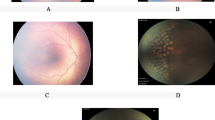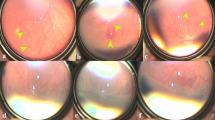Abstract
Objective
To explore the characteristics of ‘sawtooth shunts (STS)’ following intravitreal anti-vascular endothelial growth factors (anti-VEGF) for aggressive posterior retinopathy of prematurity (AP-ROP).
Design
Prospective observational study.
Methods
In a prospective observational study, 45 eyes of 24 babies receiving intravitreal anti-VEGF for AP-ROP or hybrid ROP were analyzed. Anti-VEGF molecule and doses: bevacizumab (0.62 mg or ½ IVB, n = 30 eyes; 0.25 mg or 1/5IVB, n = 9 eyes; 0.12 mg or 1/10 IVB, n = 1 eye); or ranibizumab (0.25 mg or ½IVR, n = 3 eyes; 0.1 mg or 1/5IVR, n = 2 eyes). They were followed every 1–2 week till disease regression with or without laser treatment. Development of STS, its variants, characteristics, timeline, and final outcomes was analyzed.
Results
STS occurred in 26 (57.7%) eyes at 1–6 weeks following anti-VEGF injections and persisted for 1–14 weeks. While the shunt regressed spontaneously in half of the treated eyes (n = 13) with anti-VEGF alone, the other half (n = 13) required additional laser because of either non-compliance (n = 9) or recurrence (n = 4).
Conclusion
The STS was observed to be an important retinal vascular change seen in infants treated with intravitreal anti-VEGF at half adult doses. It warrants further studies to explore the association between STS and its association with disease recurrence or regression.


Similar content being viewed by others
References
An International Committee for the Classification of Retinopathy of Prematurity (2005) The international classification of retinopathy of prematurity revisited. Arch Ophthalmol 123:991–999
Katz X, Kychenthal A, Dorta P (2000) Zone I retinopathy of prematurity. JAAPOS 4:373–376
Drenser KA, Trese MT, Capone A Jr (2010) Aggressive posterior retinopathy of prematurity. Retina 30(4 Suppl):S37–40
Sanghai G, Dogra MR, Dogra M et al (2012) A hybrid form of retinopathy of prematurity. Br J Ophthalmol 96(4):519–522
Yetik H, Gunay M, Sirop S et al (2015) Intravitreal bevacizumab monotherapy for type 1 prethreshold, threshold, and aggressive posterior retinopathy of prematurity- 27 month follow-up results from Turkey. Graefes Arch Clin Exp Ophthalmol 253:1677–1683
Padhi TR, Das T, Rath S et al (2016) Serial evaluation of retinal vascular changes in infants treated with intravitreal bevacizumab for aggressive posterior retinopathy of prematurity in Zone I. Eye 30(3):392–399
Wu L, Arevalo JF, Maia M et al (2009) Comparing outcomes in patients with subfoveal choroidal neovascularization secondary to age-related macular degeneration treated with two different doses of primary intravitreal bevacizumab: results of the Pan-American Collaborative Retina Study Group (PACORES) at the 12-month follow-up. Jpn J Ophthalmol 53(2):125–130
Brown DM, Kaiser PK, Michels M et al (2006) ANCHOR study group ranibizumab versus verteporfin for neovascular age-related macular degeneration. N Engl J Med 355(14):1432–1444
Avery RL, Bakri SJ, Blumenkranz et al (2014) Intravitreal injection technique and monitoring: updated guidelines of an expert panel. Retina 34:S1–S18
Wright LM, Vrcek IM, Scribbick FW et al (2017) Technique for infant intravitreal injection in treatment of retinopathy of prematurity. Retina 37:2188–2190
Wallace DK, Kraker RT, Freedman SF, Son AK et al (2017) Assessment of lower doses of intravitreous bevacizumab for retinopathy of prematurity: a Phase 1 Dosing Study. JAMA Ophthalmol 135(6):654–656
Fan Q, TeoYY Saw SM (2011) Application of advanced statistics in ophthalmology. Inves Ophthalmol Vis Sci 52:6059–6065
Flynn JT, Cassady J, Essner D et al (1979) Fluorescein angiography in retrolental fibroplasia: experience from 1969–1977. Ophthalmology 86:1700–1723
Morizane H (1976) Initial sign and clinical course of the most severe form of acute proliferative retrolental fibroplasias (type II) [in Japanese]. Nippon GankaGakkaiZasshi 80:54–61
Yokoi T, Hiraoka M, Miyamoto M et al (2009) Vascular abnormalities in aggressive posterior retinopathy of prematurity detected by fluorescein angiography. Ophthalmology 116:1377–1382
Harper CA III, Wright LM, Young RC et al (2017) Fluorescein angiographic evaluation of peripheral retinal vasculature after primary intravitreal ranibizumab for retinopathy of prematurity. Retina 39:1–6
Park SW, Jung HH, Heo H (2014) Fluorescein angiography of aggressive retinopathy of Prematurity treated with intravitreal anti-VEGF in large preterm babies. Acta Ophthalmol 92:810–813
Lepore D, Quinn GE, Molle F, Baldascino A, Orazi L, Sammartino M et al (2014) Intravitreal bevacizumab versus laser treatment in type 1 retinopathy of prematurity: report on fluorescein angiographic findings. Ophthalmology 121:2212–2219
Lorenz B, Stieger K, Jager M et al (2017) on behalf of the Giessen Cooperative ROP study group. Retinal vascular development with 0.312 mg intravitreal bevacizumab to treat severe posterior Retinopathy of Prematurity a longitudinal fluorescein angiographic study. Retina 37:97–111
Tahija SG, Hersetyati R, Lam GC et al (2014) Fluorescein angiographic observations of peripheral retinal vessel outgrowth in infants after intravitreal injection of bevacizumab as sole therapy for zone I and posterior zone II retinopathy of prematurity. Br J Ophthalmol 98:507–512
Henaine-Berra A, Garcia-Aguirre G, Quiroz-Mercado H et al (2014) Retinal fluorescein angiographic changes following intravitreal anti-VEGF therapy. JAAPOS 18:120–123
Perente I, Eris E, Seymen Z, Cevik SG, Bekmez S (2019) Aggressive posterior retinopathy of prematurity treated with intravitreal bevacizumab: late period fluorescein angiographic findings. Graefes Arch Clin Exp Ophthalmol 257(6):1141–1146. https://doi.org/10.1007/s00417-019-04292-4
Ekinci DY, Vural AD, Bayramoglu SE, Onur IU, Hergunsel GO (2019) Assessment of vascular leakage and its development with FFA among patients treated with intravitreal Anti-VEGF due to aggressive posterior ROP. Int Ophthalmol. https://doi.org/10.1007/s10792-019-01088-7
Funding
There is no direct support or grant related to this piece of work. However, the authors belong to an institute that receives support from Queen Elizabeth Diamond Jubilee Trust (UK), Miriam Hyman Memorial Trust (UK), Rastriya Bal Swasthya Karyakram (RBSK), and Dalmia holdings in India for its ongoing ROP work.
Author information
Authors and Affiliations
Contributions
All authors contributed to the study conception and design. Material preparation, data collection, and analysis were performed by Tapas Ranjan Padhi, Prabhjot Kaur, and Ashish Khalsa. The first draft of the manuscript was written by Tapas Ranjan Padhi, and all authors commented on previous versions of the manuscript. All authors read and approved the final manuscript.
Corresponding author
Ethics declarations
Conflict of interest
The authors declare no conflicts of interest.
Additional information
Publisher's Note
Springer Nature remains neutral with regard to jurisdictional claims in published maps and institutional affiliations.
Rights and permissions
About this article
Cite this article
Padhi, T.R., Das, T., Kaur, P. et al. Characteristics of ‘sawtooth shunt’ following anti-vascular endothelial growth factor for aggressive posterior retinopathy of prematurity. Int Ophthalmol 40, 1007–1015 (2020). https://doi.org/10.1007/s10792-019-01269-4
Received:
Accepted:
Published:
Issue Date:
DOI: https://doi.org/10.1007/s10792-019-01269-4




